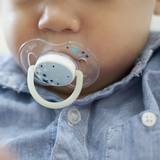Home > Hot Topics > Babies & Kids Gear > General Babies & Kids Gear > Testing Baltic Amber jewellery for authenticity
Shop
01518
https://www.under5s.co.nz/shop/Hot+Topics+Articles/Health+%26+Wellbeing/Babies/Testing+Baltic+Amber+Baby+Teething+Necklaces.html
Testing Baltic Amber jewellery for authenticity
|
Is your baby’s Baltic Amber necklace the real deal? There's a lot of amber on the market in New Zealand right now and at first glance it's difficult to tell if it's genuine Baltic Amber or plain amber, copal, or plastic. Try one of these tests to determine if the amber you have is authentic.
|
You might also be interested in ...
10 Steps to ditching your toddler's dummy
Is it time to ditch your toddler's dummy? The longer you leave it to get rid of your toddler's dummy, the more attached they will become to it. Bite the bullet while they're young and the agony will be less in the long run (although it may not feel like it at the time!). Make a start and follow these 10 simple steps.
Things to keep from your baby’s first year
So what items are good to keep from your baby's first year? Fun things to add to their memory box for when they’re older. During your baby's first year, they'll often accumulate a lot things, so it's sometimes difficult to know what to keep.
join usJoin us on social media for all our latest news. |
sign upSign up and receive our latest newsletters. |
|







Is your baby’s Baltic Amber necklace genuine?
Here are some tests you can use to find out if your baby's Baltic Amber teething necklace or jewellery is the real deal or just a fake.
Baltic Amber
There's a lot of amber on the market in New Zealand right now and at first glance it's difficult to tell if it's genuine Baltic Amber or plain amber, copal, or plastic.
Genuine Baltic Amber is the fossilised resin from ancient forests in the Baltic region of Europe. The trees in the forests fell and were carried by rivers to coastal regions where they became covered with sediment. Over millions of years the resin in the trees hardened into amber.
Baltic Amber Jewellery Tests
Try one of these 5 tests to determine if the amber you have is genuine.
1. Sight Test
Every single bead of Baltic Amber is unique so will have visible imperfections, whereas fake or plastic amber beads may be uniform and identical in colour and texture.
2. Salt Water Test
This is the easiest test to do as it doesn't damage your jewellery.
Baltic Amber is buoyant in sea water, which is why it is found washed up on the beaches in the Baltic Sea.
In a large glass of water add 3 tablespoons of salt and gently drop your amber necklace into the glass.
Genuine Baltic Amber will rise (even with the weight of the threaded string), while fake amber, plastic and copal will sink to the bottom of the glass.
Dry your necklace or bracelet in the sunlight before wearing it again.
3. Burning Test
Insert a hot needle into a bead on the necklace. Ideally, one that sits at the back, out of view, if you can.
Amber does not melt as quickly as plastic or copal when burnt, but it will burn like incense and emit a scent like burning pine.
Copal and fake amber will melt, and the plastic will release a chemical scent.
Copal will smell similar to Baltic Amber, but will melt.
4. Solvent Test
We don’t recommend using this test on your favourite amber necklace as the string may be damaged.
Apply a solvent such as nail polish remover or alcohol to the amber. The surface of copal and plastic may become tacky, or change to a honey colour, whereas amber will not be harmed.
5. UV Test
Under a shortwave UV light, copal will show barely any colour change, but Baltic Amber shows a pale shade of blue.
Beware
Beware of amber necklaces that are sold cheaply. Do your homework. They are likely to be fake or immature amber.
More Hot Topics for you to enjoy:
Source: Article written by Baltic Amber Beads